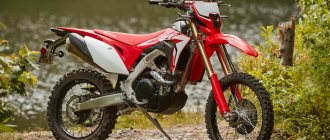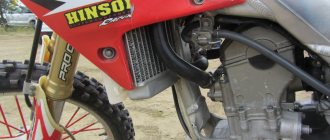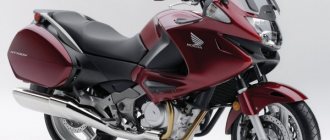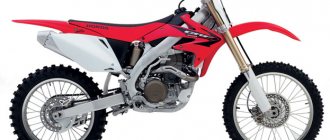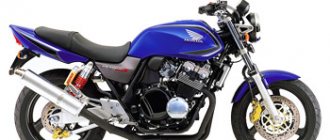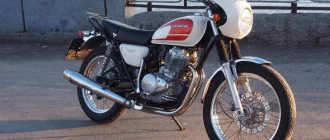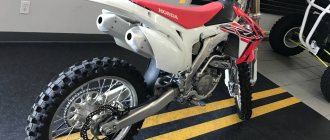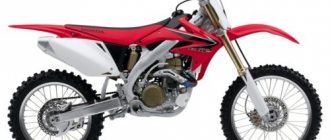At the beginning of the 21st century, Honda begins updating and gradually replacing the XR line . It should be replaced by a more modern, progressive CRF line. An important feature is that the update should not affect the change in motorcycle classes. In the old line there is a cross - it should be in the new one, there is an enduro - you need to collect an enduro based on the new line.
Of course, it is advisable to leave the engine size the same. Not every user will agree to change a bike with 250 cc to a progressive, but more power-hungry model with 300, 350 cc.
Thus was born the line of motorcycles Honda CRF 450 and the “ cheka ” - the younger sister of the Honda CRF 250 . And if the older model immediately had three modifications (X, R, F), then the 250 cc bike was presented in only 2 variations;
- Honda CRF 250 X - enduro ;
- Honda CRF 250 R - cross .
The release continues.
Construction of HONDA CRF 250
The main innovations highlighted by the CRF series include two:
- Due to the use aluminum alloys when creating the frame — the bike should become lighter. Accordingly, it handles better, turns easier, and behaves better in various road conditions.
The CRF 250 series received a reinforced aluminum frame in 2011 along with new suspension settings.
- Installed on bikes water cooling, since experiments have shown that a standard air system may sometimes not be enough.
The radiator of the cooling system is covered on the side with a plastic fairing.
Although the 250 cc modifications were developed in parallel, the developers nevertheless ended up with two separate motorcycles . They have related features, but at the same time there are differences.
Peculiarities
Both versions get upside-down telescopic front forks.
The inverted Showa fork looks serious and does not cause any particular complaints in operation.
But, if the enduro bike has a metal thickness of the stays of 47 mm , with a working stroke of 315 mm , then the cross-country model has these parameters of 49 and 310 mm, respectively. There is a difference in the rear as well.
The general design is with a mono-shock absorber , but at the same time, the enduro has a useful stroke of 315 mm , and the cross-country bike has 310 . The settings options are the same. For both models, the user can adjust the entire range of parameters.
To change the parameters of the rear suspension, use a compressed air cylinder.
Exterior
There are also minor changes in the external design of the models.
In stock, both have the brand's signature red and white livery, but the enduro version is constantly receiving new additions and colors.
Streamlined shapes and clean lines - the bike as a whole looks impressive.
Front end
- If the older sister's main difference here is the headlight or plate with the number, in the 250 cc the developers did something different. The cross version has a standard front part - a complete lack of body kit, leaving only space for a license plate.
Honda CRF 250 X - enduro with headlight.
Honda CRF 250 R – cross with a nameplate.
- The enduro has a symbolic front body kit , in the lower part of which a headlight . In 2011, the developers revised the electrical system. The result was the replacement of the stationary one with LED.
- Otherwise, the front of the bikes is identical. Large, high-raised front fender, lack of mirrors and windshield .
Rear end
The back of the bike is “clean” of any lighting equipment.
Interestingly, many stock models also have a saddle painted in the brand’s colors. But at the same time, the fuel tank cover, located in a standard place, is the only part of the bike painted black.
A cross bike has a 6.5 liter capacity, while an enduro bike has 7.5 liters. According to users, a full refueling capacity holds 7.3 liters.
The stock gas tank is painted black.
Another feature of the enduro version is the presence of two exhaust pipes that work “in sync” . The developers do not comment on the need for such a step.
The photo shows the option with two mufflers.
The remaining details of the versions are the same and fully comply with class standards.
A narrow frame, a symbolic saddle, and the presence of high pegs allow you to overcome certain problems of the track while standing.
Surprisingly, the seat will be comfortable even for a tall rider, and the seating position is closer to road than off-road.
Overview and Features
Of course, this model is considered ideal both for amateur rides and for racing, because the 250 cc engine is ideal for any extreme driving enthusiast. The Honda 250 cross-country motorcycle has the most thoughtful design and engine, and the super-strong 5th generation aluminum frame only improves the handling of the motorcycle and makes its weight quite low. The electronic injection system, introduced with an updated map, began to be used only in 2010, while the Honda CRF 250X version still used a carburetor. Since 2011, the motorcycle has been produced with new and improved suspension settings.
Particular attention should be paid to the suspension, because it is extremely important when driving over uneven surfaces and various racing tracks. At the front there is a very light Showa inverted fork with a diameter of 48 mm, and has cartridge shock absorbers with a new piston shape. This fork had a very positive effect on the motorcycle, which became more controllable and comfortable. The rear suspension is represented by a monoshock absorber with a Pro-link progression and has a stroke of 312. All shock absorber adjustments are available.
In the Honda 250 cross motorcycle, special attention was paid to appearance. This is a true cross-country professional bike, where there is a minimum of plastic (but very flexible and high quality) and maximum protection.
Specifications
Despite the fact that the engine capacity of both versions is the same, the power is different. At the same time, the difference in the issued “horses” varies by almost one and a half times.
You can be confident in the reliability of Honda engines, especially if it is a motor for a motocross motorcycle.
For a motocross motorcycle, different, forced settings are used, but the engine remains alone. This is a 1-cylinder 4-stroke engine (the first value is for cross-country, the second for enduro);
- working volume - 248 cm3;
- power - 43.30 hp;
- number of valves - 4;
- diameter - 30, 31;
- cylinders - 1;
- cooling - liquid;
- fuel supply - injector (since 2010), carburetor;
In recent years, the engine has undergone several changes - torque at low speeds has been increased, and a mode change button has appeared on the R model.
- ignition - transistor, electronic;
- start - kick starter, electric starter;
- fuel tank - 6.5 and 7.3 l.
Starting the engine did not have strict regulations. Enduro could only have a foot, while racing could only have a button and vice versa. There were versions with two working options.
Transmission and clutch
The bikes have a 5-speed gearbox. There are no special settings depending on the model.
But users note that if the bike is destined for a sporting destiny, it is better to immediately replace the gearbox with a tuned one that shifts more clearly and has less free play. In contrast, owners of enduro versions notice that the factory gearbox works quite normally, the gear ratios are selected within reasonable limits, and there is no need to apply any new solutions to it - “ it works and don’t touch it .”
The clutch cover bears the Honda inscription.
- The clutch in both versions follows the same principle - multi-disc , using an oil bath.
- Drive - chain .
Chain catcher.
Tension roller.
Chain lock.
Brakes
Both models have 1-disc hydraulic brakes. The difference is insignificant - only in the diameter of the front disc.
Therefore, only the settings of the enduro model will be given below. The cross's front disc is 20 mm wider .
The front brake disc is covered with a plastic lining, carefully made and neatly fitted.
Front brakes:
- number of disks - 1;
- diameter - 240 mm;
- support - 2-piston.
Rear brakes:
- number of disks - 1;
- diameter - 240 mm;
- support - 1-piston.
No options provided.
Dimensions and weight
The curb weight of the enduro bike was 115 kg. Version R (cross) is 10 kg less.
The Honda turned out to be quite light compared to its competitors.
The overall dimensions are also slightly different (the first parameter is enduro, the second is cross):
- in length - 2181, 2174 mm;
- width - 827, 827 mm;.
- Height - 1271, 1261 mm, square saddle - 961, 958 mm.
- Ground clearance - 322, 340 mm.
Honda CRF250R 2015 motorcycle review
Thanks to the upgrades, the motorcycle has become even better.
The Honda CRF250R hasn't received as much hype as the Yamaha YZ250F for the 2014 model year. Although the Honda was an almost entirely new design, it was the vastly redesigned Yamaha that stole the spotlight and was the focus of much of the testing and chatter in the 250cc motocross class. Okay, but if YZ is so good, then where are his titles? Led by rider Justin Bogle, the CRF250R took home another AMA 250cc Eastern Region Supercross championship in 2014. Moreover, according to statistics, the CRF250R was the most productive and popular model at Monster Energy AMA Supercross last season. Yamaha may have won the comparison tests, but Honda had no intention of backing down in competitions or in showrooms.
But rather than rest on its laurels, the Honda CRF250R returns to action for the 2015 model year with a suite of upgrades that make the bike even more adjustable. The upgrades emphasize quality over quantity, including a new Engine Mode Button that allows the driver to switch fuel and ignition modes virtually on the fly. The suspension of the CRF250R did not remain unchanged, which is now pneumatic, like on the older model CRF450R - a new 49 mm Showa Fork SFF-Air (Separate Function Fork) with three air chambers (Triple Air Chamber) is installed.
The CRF250R, with its responsive fuel injection system, produces plenty of low-end power along with good mid-range performance before running out of steam at high revs. This is a fast, yet easy to ride 250cc motorcycle.
The test drive showed that this motorcycle is a force to be reckoned with in 2015.
The CRF250R's single-cylinder, fuel-injected, single-overhead-camshaft, liquid-cooled engine was already plenty powerful last year. Its bore and stroke (76.8mm and 53.8mm respectively) provide excellent low- and mid-range torque for a 250cc engine, but it lacks a bit of torque at high revs compared to some rivals. Honda designers tried to increase the model's peak power in 2014 with a new piston and cylinder head: this helped, but it did not succeed in surpassing the Yamaha in terms of horsepower.
In this regard, it is a little strange that the company's engineers decided not to try to increase the power of the CRF250R for the 2015 model year. Instead, the goal was to unlock the full potential of the existing configuration by calibrating the ECU and using a new engine mode button that allows the driver to switch between three EFI and ignition modes to vary power delivery based on preference and road conditions.
Tuning the CRF250R's four-stroke, single-cylinder, fuel-injected engine is now easier than ever thanks to a new push-button switch between three ignition and fuel injection modes. The first mode is standard ignition and fuel supply; the second mode is designed for slippery road surfaces; third mode for sticky and deep surfaces.
Honda representatives call their engine mode switch button the first such solution in the industry, and among motocross motorcycles this is indeed the case. Essentially, this button is Honda's answer to the less convenient plug-in ignition modules on the Kawasaki KX250 and Suzuki RM-Z250. Honda's system includes three modes: the first mode is the standard ignition and fuel delivery, the second mode varies the fuel and ignition timing, making it easier to control the engine on slippery roads, and the third mode is the most aggressive and sensitive setting that adjusts the ignition timing and delivery fuel for maximum power at high speeds.
To switch the mode, the driver simply needs to stop with the engine idling and press the button located next to the throttle on the steering wheel. A flashing LED light will indicate that the mode is on: it will flash once for the first mode, twice for the second mode and three times for the third. This is much easier than returning to a filling and repair point to install another module. In addition, as last year, Honda specialists have provided the function of registering custom circuits and setting modes using additional HRC tuning tools; You can program the second and third modes in your own way, but the first, being a standard setting, cannot be reconfigured.
Modes are switched by pressing a button on the steering wheel, and a flashing LED will indicate which of the three modes you have activated.
Most of the team of test drivers preferred to drive with the first mode turned on (standard), while some rode with the third mode activated - the most aggressive and sharp. For less assertive but heavier drivers, the third mode simply helps them hold gears longer between shifts, making driving easier. The second mode turned out to be the least favorite of the three, as it takes away too much power at mid-range speeds and worsens throttle response on a long and fast track. Although it may be useful on tracks with a lot of mud and puddles. Regardless of the mode turned on, we can say that the CRF250R motor is best handled smoothly. Throttle response via the Dual-Timing PGM-FI fuel injection system and 46mm Keihin throttle body is quite crisp, but even in third mode the engine isn't as zippy or aggressive as some rival models.
Experts may not be impressed by the smooth nature of the CRF, but that doesn't mean the Honda is underpowered by any means. Excellent low-end torque translates into smooth, solid mid-range power delivery, so it's no wonder the Honda bike is so popular in motocross. But on a long track, some drivers wanted the Honda to add at least a little more agility at high revs.
On the other hand, the clutch and five-speed gearbox work amazingly well, so you can easily change gears quickly to keep the bike in the better part of the powerband. The CRF250R also sounds very good, but that's partly due to Honda redesigning the bike's two mufflers, increasing the outlet diameter of the right muffler from 22 to 23.8 millimeters, and the left muffler from 23.4 to 26.6 millimeters.
The CRF250R's handling is almost perfect: excellent steering precision and stability thanks to the Honda Progressive Steering Damper. The motorcycle responds precisely and quickly to steering movements, but at the same time is incredibly stable at high speeds.
It may not be the fastest bike on a straight track, but where the CRF250R really shines is in corners and rough terrain. The aluminum frame handles with incredible precision, and the low center of gravity keeps the bike stable in ruts and bumps. The wheelbase, rake and trail are all unchanged from the 2014 model, and last year's subframe and air intake changes still keep the bike compact and light between the thighs.
The narrow driver's seat allows him to distribute his weight as efficiently as possible, moving it where it is needed while driving over bumps, a flat section of the road or off-road. However, some testers complained that their knees sometimes hit the sharp radiator shroud. Some riders even cover it with something.
The new 49mm Showa SFF-Air air fork makes the CRF250R's front suspension even more configurable. Moreover, her work on the track can convince skeptics who do not believe in the benefits of air forks.
Honda decided to replace the 2014 model's excellent Showa Separate Function Fork (SFF) with a 49mm Showa Separate Function Fork Triple Air Chamber (SFF-Air). This makes the bike 1.2 kilograms lighter and adds adjustability compared to a traditional spring fork. The right leg of the fork houses damping mechanisms to control compression and rebound, while the left leg houses a three-chamber air spring system. The right leg has 16-position adjustability for recoil and compression damping, as well as nearly infinite firmness adjustment.
In the left leg of the fork, the compensation chamber affects the spring rate during the early part of the fork's travel and low speed, while the inner chamber affects the spring rate throughout the entire range of the fork's travel. The outer chamber contains fork oil and air under ambient pressure; Adjusting the oil level in this chamber affects the spring rate only when the fork is almost fully compressed. Preload and how much the motorcycle sags under the rider's weight is changed by adjusting the air pressure in the inner and compensation chambers using the Schrader valve on the fork cover and changing the volume of oil in the outer chamber. The pressure in the compensation and internal chamber can be adjusted on the track using an additional Honda pump depending on conditions. Since the SFF-Air fork uses such high pressure (189 psi maximum), the manufacturer notes that any increase in pressure due to the fork heating up during operation is negligible.
The fork can (and should) be adjusted at your discretion, and it will delight you with its performance both on small bumps and on large bumps. The Honda Pro-Link rear suspension guarantees a smooth ride on any track.
The rear single reservoir Showa shock on the 2015 CRF250R gets a slightly lighter and stiffer spring. The shock absorber body remains unchanged; There's a 17-position recoil adjustment along with a 13-position low-speed compression damping adjustment and a 3.5-turn high-speed adjustment.
Air forks have yet to gain the trust and love of the public, as they can cause some problems in off-road conditions, which is where motocross bikes spend most of their service life. However, the new SFF-Air fork is a definite step up from last year's CRF250R. Setting it up just takes some getting used to, and Honda representatives warned drivers that constantly fiddling with air pressure is not the optimal way to adjust compression and rebound - you need to use adjusters. But they're like sensitive bathroom faucets: just one click of the control knob can be the difference between a perfect setting and a feeling that something isn't quite right. But once you adjust the settings to your liking, the suspension will handle small bumps and big jumps just fine.
With its excellent chassis, the CRF250R feels comfortable even in the air.
The Pro-Link rear suspension, in turn, confidently does its job perfectly. The motorcycle rides smoothly over ruts, potholes and bumps, and also lands firmly after jumps. That stability also comes courtesy of Honda's Progressive Steering Damper (HPSD), which helps the bike maintain quick, precise steering while mitigating high-speed shake.
The new CRF250R should brake better, as the size of the front wave-shaped brake disc has been increased from 240 to 260 millimeters. In truth, test drivers didn't notice much of a difference, as last year's 240mm disc already worked just fine. Dunlop Geomax MX52 motocross tires are another new product for the 2015 model. They hold traction well in a variety of rough terrain conditions.
The design of the 2015 CRF250R has also been updated. The bike looks a little different thanks to new fork guards that should better protect it from stones. The radiator grille and some parts of the brake system are now finished in black to match the new color scheme and set of CRF decals.
The bottom line is this: the new Honda CRF250R is definitely worth the money, and the manufacturer has not increased the price, despite the new engine mode switching function and the use of the SFF-Air air fork.
During the test drive, it was impossible to have time to tinker with the engine settings and try to squeeze out at least a little more power at high speeds. In truth, this is the only thing you can complain about here. Otherwise the bike is very, very good.
Honda CRF250R 2015 Specification | |
| engine's type | 249 cc single-cylinder four-stroke liquid-cooled |
| Bore/Stroke | 76.8 mm. / 53.8 mm. |
| Compression ratio | 13.5:1 |
| Valve mechanism | Unicam®, 4 valves; intake 30.5 mm., titanium; exhaust 25 mm., steel |
| Fuel system | Dual-TimingPGM-FI fuel injection system, 46mm throttle body. |
| Ignition | Transistor with electronically adjustable advance |
| Transmission | 5-speed with close ratios |
| main gear | #520 chain; 13T/49T |
| Front suspension | ShowaSFF-Air 49 mm inverted fork. with 16-position recoil adjustment and 16-position compression damping adjustment; stroke - 310 mm. |
| Rear suspension | Pro-Link with one Showa shock absorber with adjustable spring preload; 17-position recoil damping adjustment; compression damping is divided into low speed (13 positions) and high speed (3.5 turns); stroke - 312 mm. |
| Front brake | Single 260mm wave disc with two-piston caliper |
| Rear brakes | One 240mm wave disc |
| Front tire | Dunlop MX52 80/100-21 |
| Rear tire | Dunlop MX52 100/90-19 |
| Wheelbase | 1488 mm. |
| Rake | 27° 23’ |
| Trail | 118 mm. |
| Seat height | 950 mm. |
| Ground clearance | 322 mm. |
| Tank capacity | 6.4 l. |
| Color | Red |
| Declared curb weight* | 105 kg. |
| *includes all standard equipment, necessary fluids and a full tank of gasoline | |
Driving performance
Acceleration to 100 km is 5 seconds. The measurements were carried out under factory conditions.
According to users, 95 is reached even faster, but the bike simply does not want to accelerate further.
Maximum speed
The maximum speed declared by the developers is 100 km/h . According to users, with the correct settings, the cross version can reach 150 km/h. True, the headwind interferes greatly.
Fuel consumption
Fuel consumption depends on road conditions, but with the right settings it does not rise above 4.5 liters. per 100 km .
Honda XR 250
Brief review of Honda XR 250
The Honda XR 250 series of motorcycles includes three modifications - the enduro XR 250 R, the motard XR 250 Motard and the domestic Japanese version XR 250 Baja, which also belongs to the enduro class, but has differences in appearance, suspension and gas tank. All motorcycles in the series are equipped with 1-cylinder air-cooled engines with a dry sump and have an oil tank located directly in the frame. The Motard modification, in addition to other wheels, has a more powerful front brake and shorter-travel and stiffer suspension.
Despite the above differences, the various modifications of the Honda XR 250 have much more similarities, and since this motorcycle can be called very popular and therefore widespread, there are no problems with finding spare parts. However, this model enjoys a reputation as an extremely reliable and fault-tolerant motorcycle, especially in everything related to the engine and gearbox.
Technical characteristics of Honda XR 250
- Years of production: since 1995
- Class: enduro / motard
- Frame: tubular steel
- Engine: 4-stroke, 1-cylinder
- Engine capacity, cubic meters see: 249
- Cooling: air
- Valves per cylinder: 4
- Fuel supply: carburetor
- Power: 28 hp (at 8000 rpm)
- Torque: 26 Nm (at 7000 rpm)
- Maximum speed, km/h: 130
- Acceleration from 0 to 100 km/h: ~8 seconds
- Transmission: 6-speed
- Wheel drive: chain
- Front Tire: 80/100-21 (XR 250R and Baja) / 110/70-17 (XR 250 Motard)
- Rear Tire: 100/100-18 (XR 250R and Baja) / 130/70-17 (XR 250 Motard)
- Front brakes: 1 disc 245 mm (XR 250 Motard - 260 mm), 2-piston caliper
- Rear brakes: 1 disc 220 mm, 1-piston caliper
- Front suspension: telescopic fork with rebound adjustment (XR 250 Motard has inverted fork with preload and rebound adjustment)
- Rear Suspension: Progressive monoshock with preload adjustment (XR 250 Baja; XR250R and XR 250 Motard with preload and rebound adjustment)
- Fuel tank volume, liters: 14 (XR 250 Baja) / 9.7 (XR 250R and Motard)
- Fuel consumption at 110 km/h, liters: ~3.6
- Dry weight, kg: 135 (XR 250 Baja) / 116 (XR 250R and Motard)
Pros and benefits of the Honda XR 250
- Light weight
- High reliability
- Great resource
- Maintainability
- Excellent handling
- Economical
Pros and cons of the Honda XR 250
- Low power
- Strong vibrations at high speeds
- Under severe off-road conditions, the engine is prone to overheating.
- Small gas tank (except Baja version)
Modifications (CRF250L, CRF250M, CRF250L Rally)
In addition to those described on the Internet, there are references to three more modifications.
- Honda CRF250L - an enduro motorcycle that has common features with the development of the plant CBR250. Deformed engine, complete absence of any settings for the suspension, at least some innovations, steel frame.
It’s better not to go into such jungle on a lightweight version, and Honda itself classifies the L-ku as a dual-purpose bike, and not as an uncompromising “dirt mixer”.
- Honda CRF250M assembled on the basis of the previous one, full compliance with technical characteristics, road tires and wheels of the same diameter classify it as a motard.
Already from its appearance it is noticeable that the M is more oriented towards road use.
- Honda CRF250L Rally is the next stage of development of the L model. Increased height, ground clearance, larger brake discs and stock ABS for European markets.
Apart from the same engine capacity - 248 cm3, there are no other common parts. The first two models were presented by the concern for budget users in 2012.
If we compare in numbers, budget models initially lag behind the R and X versions, which the developers position as the flagships of the line.
Users note that these budget versions have one big advantage - an almost ideal weight distribution of 46/54% , which makes riding such a bike no more difficult than a bicycle ride.
Flaws
- Difficult to maintain.
- It's not easy to catch neutral.
- You need to get used to the sensitive reaction to the movement of the gas/brake handles.
Advantages
- Dynamism and traction.
- Checkpoint.
- Maneuverability.
- Lightweight and manageable.
I spent quite a lot of time studying this bike (CRF250L/M/Rally) based on reviews and discussions. The motorcycle is intended for the Asian market and is produced there. Made for people for whom 250 cc is like our 600 or even 1000. The M and Rally versions are external stylizations of a motard and a rally car, which, naturally, cannot be used as a mischief like a motard, nor can you drive the Dakar. But showing off or just enjoying the appearance is fine. Outside of Asia, it is an entry-level enduro (dual sport) competitor to the KLX250. When you see that 2/3 of the jebels from auctions come with city tires, most of the questions about why this model is the way it is disappear. Users don't drive through shit - users get a more roadworthy bike.
Pros: cheaper than competitors, cheap original spare parts made in Thailand, perpetual motion machine from the CBR250R - there are reviews of cars that have lasted 250-300 thousand without capital (and this is a check!!), long service intervals. Injector (somewhere one DRZ400 was sad). Good for beginners - the seat is lower than competitors, a low center of gravity and a spring ring instead of one disc in the clutch - for those who use it for the first time in their life and throw it away. The ring can be replaced with a regular disc if desired. 6 gears! (The DRZ400 is even more sad) and the engine from a sports car (and don’t argue, the Thais race ShKMG on the CBR250R with this engine) allow you to ride 140 crouched down, while the engine does not go crazy and feels normal (unlike a madman in the saddle). The end result is an excellent appearance and the resulting suitability for external customization. The Thais make masterpieces out of them, sparkling with bright anodizing, chrome and decals.
Cons: conditional drawback - little power and bad ride (I don’t consider this a disadvantage, but it needs to be pointed out), non-adjustable (unlike the KLX250) suspension, so fat “riders” go through the woods. There is also a certain stigma about a motorcycle for a beginner - if you start improving it (and there is something to improve - exhaust, EJK, 305cc bigbor, adjustable suspensions), then you will spend a lot of money, but this will not make the motorcycle much better and it would be wiser to just buy a better motorcycle. I think the maximum that is reasonable to put is other stars. If you are Thai, if you are a beginner, if you are a person of small weight and dimensions, if off-road driving is limited to a decent dirt road, and in general in life you are urban, if you need indestructible resource bikes for rental in some Phuket - the CRF250L is your choice. If you want something advanced and for the forest, if you are tall or fat - bypass, completely bypass.
Something like this. I'm sure I forgot something, but oh well.
conclusions
Currently, the Honda CRF 250 in flagship versions is one of the leaders among the huge variety of enduro-cross motorcycles.
The sensitive reaction of the motorcycle to the movements of the gas/brake handles can cause problems for an inexperienced user at first. But at the same time, both types of bikes imply that a person who already understands a lot about motorcycles will sit behind the wheel.
For enduro lovers, the Honda CRF 250 will be a real gift , allowing you to climb where even an SUV gets stuck without any problems or questions.
Various additional equipment is available for bikes of this series, for example, protection of the exhaust manifold and engine.
Honda CRF250 Rally: first look
Honda has returned to its lineup a dual-purpose motorcycle in a configuration suitable for both everyday use and long-distance travel... with a 250 cc engine. For many years, the company had such a mega-gun in its line - the XR250 Baja, whose name became a household name - “to Mongolia in Baja.” Will the 250 Rally become the new Baja?
MOTOGONKI.RU, March 30, 2021 — The motorcycle first appeared in public back in 2015, at the Motor Show in Osaka, and the production version appeared before the Europeans at the Milan Motor Show EICMA-2017, moreover, in an “evil” rally body kit - with a “tower” release from “Akrapović” and all that – to give the impression that this is a “mini CRF450 Rally”. After a couple of years, the bike was lightened – and that’s good!
Honda CRF250RL Rally (2019)
After Osaka, everyone expected the CRF 250RL to appear (including in Russia), but this did not happen. The reason was the design features of the first edition of the CRF 250 Rally - its “sportiness”. That is, Honda really planned to launch a “mini Dakar” into the series, with a tough 35-horsepower engine of the new generation CRF250R (79 x 50.9), with two-way exhaust. However, this would also require regular maintenance: valve adjustment every 5000-7500 km. Is it necessary?!
The new CRF250R engine would probably come in handy... at the Dakar. But not for everyday use!
The CRF 250 Rally, which came to Russia from the Honda plant in Thailand, has a simpler face: the engine from the CBR250R with a compression ratio of 10.7:1 fits perfectly into the new frame!
Engine from CBR250R: CRF250Rally on the left, donor on the right
The production version is aimed at everyday use in the most awkward conditions, say, far from civilization. And disassembling the motorcycle is carried out literally with two hexagons, which are included in the kit.
The symmetry of the initial design is slightly disrupted by the large glove compartment on the left
By the way, traces of the original design for the new cross-country engine are visible throughout: the chassis and lining initially meant the installation of two exhaust pipes, but then a voluminous glove compartment appeared on the left side of the motorcycle.
The symmetry of the initial design is slightly disrupted by the large glove compartment on the left
True, it is not so large as to occupy the entire niche previously intended for release.
The engine from the CBR250R is hidden under the plastic.
Engine 24.4 hp has a softer - “comfortable” characteristic and divine performance requirements, as expected for a motorcycle successor to “that same Baja”. It goes great on the highway and pulls off-road. The Rally's power output is a couple of horsepower higher than the pure enduro 250L. There are other differences between them, which determined the choice of the Russian representative office in favor of supplying the “rally” version.
Honda CRF250 Rally is taller and longer than the 250L urban enduro
Small engine for big people
In terms of chassis, the differences with the enduro are noticeable to the naked eye: the Rally is 50 mm higher, the suspension travel is the same 50 mm more, the wheelbase is 12 mm, the seat height is 899 mm versus 875 for the enduro, the tank is 2.3 liters larger - 10 ,1 l.
Honda CRF250RL Rally frame and subframe
Overall, the bike was not originally intended to be an “entry level” bike. This is exactly the successor to Baja, which was often bought from us at auctions in Japan for pennies, and then exploited for years.
The motorcycle is equally suitable for both a person 165 cm and 190 cm tall. The fork has no adjustments; the shock absorber can be adjusted to suit you (and this will probably be the first step when purchasing, for example, as part of pre-sales preparation) - once and for all.
Honda CRF250RL Rally shock absorber adjustment must be done at a service center
The rear shock absorber in the base is very soft and needs to be tightened immediately so that a pilot weighing 90+ feels more confident. Preload adjustment is not easy to get to because the shock absorber is hidden under plastic panels.
Everything has been taken care of
Another feature of the 250 Rally 2018-2019 model is its ability to consume the worst fuel in the world. The Japanese planned that the motorcycle would be used in countries such as Thailand, Malaysia, Indonesia and India. In the countries of Southeast Asia, by the way, there were no problems with the quality of gasoline. But as for India, anyone who has been there will understand: sometimes that liquid called “gasoline” burns, and that’s all, and solid debris and suspended matter are the scourge of the Indian crowd. Honda engineers have provided for the possibility of clogging of the fuel line and filters so that the tourist does not stand motionless halfway between refueling and service.
Honda CRF250 Rally tank is 10 liters - more than the CRF250L enduro
The fuel pump creates constant pressure in the system so that the injector consistently produces the desired mixture quality. There are two valves in the gas tank. One regulates the pressure in the tank to prevent gasoline from leaking out of it in the event of a fall, and on the other hand, relieves the pressure on hot days when too much vapor is generated. The second valve regulates the fuel supply. And there is also a ventilation system in the tank. Fuel enters the injector through a pump through a filter. If the filter becomes so clogged that it is unable to pass gasoline, the breather on the purge system opens and fuel begins to flow into the pump directly from the tank, bypassing the fine filter. In this case, the engine power is limited, but you can continue driving: as long as there is enough gasoline in the tank and the level is above the breather, dirt accumulated at the bottom will not get into the fuel pump and injector. This is your chance to get to the service!
Honda CRF250RL Rally: Sunstar brake disc, Nissin caliper and IRC TRAILS GP-22R tires
Not as simple as it seems
The relatively high price of the 250cc motorcycle is also due to some features that marketers would call “premium”, although this is simply a tribute to market trends. Full LED optics are among them.
Asymmetrical headlamp design - heritage from the XR250 Baja
The asymmetrical double headlight of the Honda CRF 250 Rally became a kind of reference to the design of the XR250 Baja; here, too, one headlight is low, the other is high. The turn signals and brake lights are also diode.
Durable rubberized headlight gasket
Funny freak? This is functionality!
The headlights of the CRF 250 Rally are framed by a rubberized gasket, although the housing itself is plastic. The gasket simultaneously protects the headlight unit from dirt and dust, and acts as a bumper. Although it does not carry any special meaning.
Honda CRF250 Rally dashboard - simple and clear
The instrument panel is modern, liquid crystal, although quite simple in functionality - similar to the one installed on the CB300R.
Inside, the CRF 250 Rally is much more stuffed with all sorts of electronics than it might seem. When we disassembled the CB300R and found out why it needed a high-tech “anti-wheelie” system, we looked at a simple inertial platform with gyroscopes - on an “entry-level” motorcycle, on a “300”! So, the CRF 250RL also has position sensors.
Rear brake circuit ABS is disabled
Rally is equipped with a gyroscope system that determines the position of the motorcycle in space. This system is connected to the ECU and a number of sensors responsible for supplying power to the wheel: tied together - mass air flow sensor, air temperature, throttle position, speed sensor, lambda probe - all this helps the ECU adjust the power and ignition “map”.
Where should I put it?
I’ll try to answer one of the questions that immediately arises: where should I put my luggage?
Green lines mark a) the subframe boundary and b) the factory fastening line
The CRF250 Rally's subframe is steel and extends all the way to the brake light, ensuring that a good load can be secured to the seat. But there is nowhere to constructively hang hard cases: frames, if any exist (or appear) in nature, no one has yet seen; It’s not easy to figure out how they can be installed - due to the shape and mounting of the muffler, as well as the location of the glove compartment on the left. After removing the rear plastic, we made sure that the subframe was in place. The subframe has a recessed fastener for securing the saddlebag. He also attaches the plastic casing.
Like: we warned you!
The warning sticker states that the tail load limit is only 4.5 kg, and the total load (with passenger and cargo) should not exceed 159 kg.
Honda CRF250 Rally
It can be seen that the tail section is not monolithic, but welded. Here the engineers decided to play it safe: there were cases when riders loaded the “tail” with everything they could get their hands on, and then cheerfully rode with it all over the rocks. It is clear that this is how everyone will operate the CRF 250, but in case one day the “tail” falls off along the weld seam under an unbearable burden, the company can always say: “well, we warned you.” And such a reaction from the service center will be more than normal!
Rear brake circuit ABS is disabled
The motorcycle's off-road functionality is slightly enhanced by the ability to disable the rear ABS circuit. The front circuit is always engaged.
Honda CRF250RL Rally
The crankcase protection and levers/handles are plastic, which is a design element, but still performs a protective function. Do you remember that on the Africa Twin the manufacturer fundamentally did not replace the plastic “burdocks” with hard aluminum in 2021? The reason is that it’s cheaper for the owner! Replacing a broken plastic hub, which costs about $40, is much easier than replacing a bent steering wheel, which costs over $150. Plastic protection, oddly enough, works great in 80% of cases - from stones flying from under the wheel of a motorcycle in front, for example. When falling, it “plays” and absorbs part of the impact quite successfully.
Honda CRF250RL Rally (2019)
The motorcycle is equipped with a number of protective plastic shields, such as heel protection, sprocket protection, rear fender liner as standard, fork protection, exhaust pipe protection (scald protection) and so on. The crankcase protection, of course, requires closer consideration (and replacement with aluminum).
Grippy pilot footpegs - without any rubber bands, like on the Africa Twin
In general, the Honda CRF250 RLA (Rally ABS - this is the model being supplied to the Russian market this year) is an interesting device and worthy of attention. Moreover, there is simply no analogue from competitors on the market at the moment.
PS You can study the CRF 250 Rally in detail at the MotoSpring 2019 exhibition from April 5 to 7 at Expocenter. The first batch of motorcycles has already arrived at dealerships, but were purchased while still on the way. This motorcycle in the photo is one of those already sold, as it turned out. The second is expected in April and will be more numerous.
